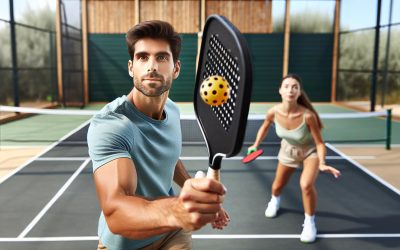Pickleball’s skyrocketing popularity isn’t just about fun and games; it’s also about mastering the skills that make a player stand out. Among these, having a solid grip on your paddle is crucial. It’s the foundation of every shot, dictating the power, accuracy, and spin of the ball. Yet, it’s often overlooked, with players focusing more on strategies than the basics of grip.
Getting your grip right can transform your game from good to great. Whether you’re a beginner trying to find your footing or an intermediate player looking to refine your technique, understanding the nuances of pickleball paddle grips is key. It’s not just about holding the paddle; it’s about controlling the game. Let’s dive into the world of pickleball paddle grip techniques for better control, where small adjustments can lead to big wins.
Importance of a solid grip on your pickleball paddle
When stepping onto the pickleball court, one of the first skills players should master is the grip of their paddle. A solid grip is the cornerstone of every shot, whether it’s a swift serve, a daring dink, or a powerful drive. Without the proper hold on their paddle, players might find their shots lacking in both precision and power.
One of the chief reasons why a solid grip is paramount is because it directly affects the ball’s trajectory. A loose or incorrect grip can cause the ball to veer off in unintended directions, making it difficult to execute strategic plays. Furthermore, grip strength plays a crucial role in determining the power behind a shot. A firm yet flexible grip allows players to transfer energy from their paddle to the ball more effectively, ensuring that their shots have the desired speed and force.
Additionally, a solid grip enhances a player’s ability to impart spin on the ball. Techniques like the topspin, backspin, or sidespin require precise wrist action, which is only possible with a correct grip. By mastering their grip, players can add an extra layer of complexity to their shots, making it more challenging for opponents to predict and return the ball.
It’s also worth noting that having a comfortable and solid grip reduces the risk of injuries. Repetitive stress on the hands and wrists is common in pickleball, but an optimal grip can alleviate unnecessary strain. This aspect is especially crucial for players who engage in long matches or play frequently. By preventing injuries, players can ensure that they stay in the game longer and maintain a consistent level of play.
To truly understand the significance of a solid grip, consider the experiences of both beginners and seasoned players. Beginners often struggle with control and direction in their early games, mainly due to an unstable grip. As they refine their grip technique, they quickly notice improvements in their accuracy and power. Seasoned players, on the other hand, continuously adjust their grip based on the shot they intend to make, showcasing the dynamic nature of pickleball play. These adjustments can be minor, but they have a significant impact on the game’s outcome.
Understanding the basics of grip

When someone dives into the world of pickleball, mastering the art of gripping the paddle is paramount. This foundational skill isn’t just about holding the paddle; it’s about unlocking the potential for precision, power, and injury prevention. The way a player grips their paddle directly influences the outcome of each shot, and ultimately, their entire game.
The grip should feel natural, like an extension of the hand, ensuring the player can react swiftly and accurately during fast-paced exchanges. Proper grip technique allows for a seamless transition between forehand and backhand, without losing power or control. It’s all about finding that sweet spot – a grip that is neither too tight, causing tension and fatigue, nor too loose, leading to a lack of control and power.
There are primarily two types of grips in pickleball: the Continental Grip and the Eastern Grip. The Continental Grip is preferred for its versatility, allowing players to effortlessly switch between different types of shots without adjusting their grip. It’s achieved by holding the paddle so that the thumb and index finger form a ‘V’ shape that aligns with the edge of the paddle. This grip is ideal for serves, volleys, and dinks, providing a balanced mix of control and power.
On the other hand, the Eastern Grip offers a bit more comfort and is easier for beginners to adopt. This grip positions the hand so the ‘V’ created by the thumb and index finger is more towards the paddle’s face, offering enhanced control over forehand shots and facilitating a more natural swing motion.
| Grip Type | Advantages | Ideal For |
|---|---|---|
| Continental Grip | Versatility in shots, balanced control and power | Serves, volleys, dinks |
| Eastern Grip | Natural swing motion, enhanced control on forehand shots | Beginners, forehand heavy play |
Regardless of the grip chosen, it’s crucial to ensure that the handle size of the paddle is a good fit for the player’s hand. A handle too large or too small can greatly affect comfort, control, and the ability to grip the paddle correctly. Most manufacturers offer paddles with different grip sizes, accommodating players with varying hand sizes.
Different grip techniques in pickleball

In the world of pickleball, mastering different grip techniques is key for players looking to elevate their game. Beyond the basic Continental and Eastern grips, there are several other styles each player can adapt to improve their control, power, and spin on the court.
The Western Grip
This grip is less common in pickleball but offers unique advantages for certain plays. It’s characterized by placing the hand further underneath the handle, which naturally opens up the paddle face. The Western Grip is especially beneficial for those looking to add topspin on their shots, as the angle of the paddle allows the ball to dip quickly over the net. However, it requires a good deal of wrist flexibility and strength to execute effectively.
The Vardon Grip, or Double-handed Backhand
Popular among tennis players, the Vardon Grip involves using both hands on the paddle for backhand shots. This grip provides extra power and stability, making it ideal for players who struggle with backhand strength using a one-handed approach. It allows for more significant torque and control, but can limit reach and mobility slightly.
Grip Pressure and Adjustments
An often overlooked aspect of pickleball grip techniques is the pressure applied by the hand. A firm yet relaxed grip pressure is vital for maintaining control over the paddle without causing unnecessary fatigue or strain. Players should learn to adjust their grip pressure dynamically during a game, tightening it for power shots and loosening it for more delicate touches.
Adjusting for Specific Shots
- Serves and volleys: A slightly firmer grip helps in adding power.
- Dinks: A softer grip increases touch and feel.
- Drives: Moderate pressure aids in control at high speeds.
Choosing the Right Handle Size
Handle size plays a crucial role in how effectively a player can implement these grip techniques. A handle that’s too large or too small can hinder grip adjustments, reduce comfort, and ultimately affect in-game performance. Players should select a paddle with a handle size that fits their hand snugly, allowing their fingers to wrap around comfortably without too much overlap.
| Grip Type | Benefits | Ideal For |
|---|---|---|
| Continental | Versatility in shot types | Players favoring quick switches |
| Eastern | Control on forehand shots | Beginners |
| Western | Topspin and dip over the net | Advanced top spin lovers |
Choosing the right grip for your playing style

When it comes to maximizing performance on the pickleball court, selecting the appropriate grip based on your playing style isn’t just important—it’s crucial. Different grips can significantly impact your ability to control the ball, apply spin, and even influence your comfort and endurance during long matches. Understanding the nuances among various grip options will help players tailor their equipment and technique to suit their individual needs.
The Continental Grip, traditionally favored for its versatility, serves well for players who engage in a balanced mix of shots. It’s particularly effective for those who prefer a straightforward style of play, focusing on consistency and precision over power. The grip allows for easy transitions between forehand and backhand, making it ideal for beginners or intermediate players looking to solidify their fundamentals.
On the other hand, the Eastern Grip offers a slight modification, positioning the hand under the paddle for those looking to generate more forehand spin. This grip suits players who are aggressive from the baseline, aiming for shots that dip quickly and challenge opponents. It requires a bit more wrist flexibility but rewards players with enhanced control over spin-heavy shots.
For modern players who prioritize topspin and power, the Western Grip emerges as a compelling choice. This grip dramatically shifts the hand’s position to the underside of the handle, facilitating a high-to-low swing path that naturally imparts topspin. While it may take some time to master, the western grip is a favorite among advanced players seeking to dominate with powerful, spin-laden drives.
Table: Summary of Grip Choices Based on Playing Style
| Grip Type | Benefits | Ideal for Players Who |
|---|---|---|
| Continental | Versatility, Easy transitions between shots | Prefer consistency and precision |
| Eastern | Enhanced forehand spin, Good for aggressive play | Enjoy baseline aggression |
| Western | Topspin and power, High-level control over spin | Seek power and topspin |
Furthermore, the Vardon Grip, or the double-handed backhand, shines for players leveraging strength and stability for their backhand shots. Originating from tennis, this grip provides extra support, allowing for powerful, controlled backhands. Players familiar with tennis may find this grip particularly comfortable and effective for transitioning shots and defensive plays.
Adjusting your grip for better control

Once players have a good understanding of the various grip techniques available in pickleball, the next step is to refine these grips for better control and performance on the court. Adjusting your grip might seem minor, but it can significantly impact your play. Here, we’ll go over how subtle changes in how you hold your paddle can improve your game.
Finding the Sweet Spot
Every pickleball player has a natural grip, but fine-tuning this grip brings out the best in your game. The sweet spot on a paddle isn’t just a physical location; it’s also about how your hand connects with the paddle.
- Loosen up: Many players tend to hold the paddle too tightly, which can restrict movement and reduce flexibility in wrist motion. A more relaxed grip allows for better wrist action, crucial for snapping shots and adding spin.
- Adjust for shot type: For groundstrokes, a firmer grip enhances control. When it comes to serves and volleys, slightly loosening the fingers can provide the flexibility needed for faster, more reactive shots.
Switching Grips Mid-Game
The ability to switch grips quickly during play is essential for advanced players. This skill allows for seamless transitions between different types of shots, a necessary trait for competitive play.
- Practice makes perfect: Regularly drilling the motion of changing grips can improve muscle memory, making the transitions feel more natural during a match.
- Know when to switch: Identifying the right moment to change grips is as important as the switch itself. Transitioning too early or too late can throw off your timing and impact shot quality.
Grip Adjustments for Better Spin Control
Spin is a critical element of pickleball, affecting the ball’s trajectory and bounce. Adjusting your grip can help in exerting the right amount of spin on the ball.
- For topspin: Rotate the paddle slightly forward in your hand. This adjustment helps in brushing up behind the ball, necessary for topspin.
- For backspin: Conversely, tilting the paddle back can aid in achieving the desired backspin by allowing the player to slice under the ball effectively.
The Role of Paddle Weight and Shape
Paddle weight and shape can influence how a grip adjustment impacts play. Players should consider these factors when fine-tuning their grip.
- Heavier paddles: Generally require a stronger, firmer grip since they provide more power but less control.
Conclusion
Mastering the art of pickleball paddle grip is essential for elevating your game to the next level. It’s not just about choosing a grip but also about adjusting and switching as the game demands. Remember, the right grip can enhance control, improve performance, and allow for a more dynamic play style. Whether you’re a beginner or a seasoned player, taking the time to experiment with different grips and understanding how paddle weight affects your control can make all the difference. So grab your paddle, find your sweet spot, and get ready to dominate the court with newfound confidence and skill.













0 Comments